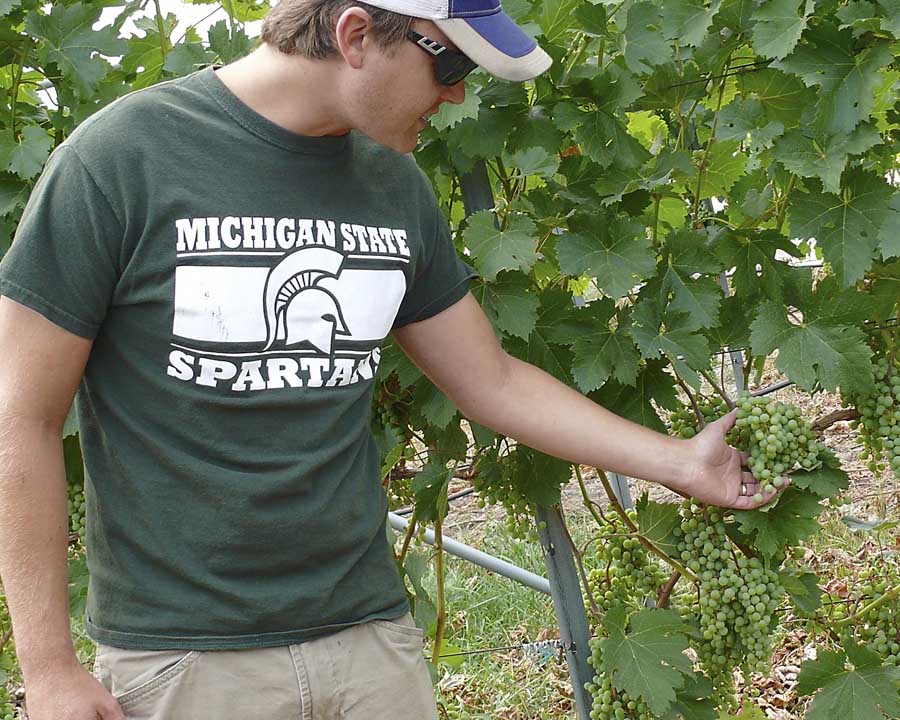
Mari Vineyards is not only unique for its winery, but also for the varieties it grows. These include Nebbiolo, Schioppettino, Malbec and Sangiovese. High tunnels encourage these cultivars by extending the growing season by about a month. (by Leslie Mertz)
Mari Vineyards typically begins setting up the high tunnels over its vines in late April, as soon as vineyard manager Sean Noell thinks the last “really cold night” has passed.
With the heavy plastic sheeting of the sidewalls extended fully to the ground, and the end doors open, the high-tunnel temperature can be 20 degrees warmer than the outdoor temperature.
“Even in a cooler year, if I keep the doors shut, I can get it to be 80 to 85 degrees in the tunnel every single day, and that’s what I shoot for. That gives us an average of 20 to 25 more growing degree-days per season,” he said.
The tunnel plastic stays up until about the beginning of November and is then removed so the vines can go into hibernation.
High tunnels require a good deal of labor. Mari Vineyards’ tunnels are 600 feet long, with one large piece of plastic.
Ten workers minimum are required to lift it, plus the winery built a man-lift on a tractor “so someone could be up there in the middle spreading it out,” he said.
In addition, when summer temperatures increase to the point that the tunnels get too hot, workers must raise the tunnel sidewalls, securing them with rope clips that Noell and his team developed.
Elevation is something to think about when adding a high tunnel, he said. Mari Vineyards rows run up a slope, so the tunnel acts as a chimney, drawing in cooler air through the door at the bottom of the hill.
As the air rises through the tunnel, it warms and eventually flows out the door at the top of the hill.
“The temperature in the lowest 50 feet or so is actually cooler than it is outside, because it’s not only pulling in that cooler air but the plastic cover also acts like a shade,” he said.
That’s actually a good thing, though, because the air movement eliminates the need to vent heat except on the very hottest of summer days.
Tunnels set on flatter ground, on the other hand, would lack the chimney effect, and would be more likely to get hot during the dog days of summer. They would also require more finessing with the sidewall height and consequently higher labor costs to raise and lower them, he said.
Strong winds are also a concern with high tunnels because they can tear the plastic, and possibly uplift the whole tunnel.

Grapes under the high tunnels not only have longer to ripen, but the vines are healthier than their counterparts grown without the tunnel’s protection, says vineyard manager Sean Noell. He oversees all 56 acres of Mari Vineyards, including the 8 acres under the high tunnels. (By Leslie Mertz)
“If it gets really windy, you’re supposed to raise up the sidewalls really high, and we’ve had to do that a couple of times when we’ve had a steady high wind of 60 mph or so,” Noell said.
For run-of-the-mill thunderstorms, though, he just leaves the tunnels alone.
“The first year we set up the tunnels, we were really diligent about coming out and venting them whenever the weather forecaster said there was a possibility of damaging winds, which was basically for every single storm,” he recalled.
Overall, he estimated they spent about $20,000 that year just pushing the plastic up and down — about the cost of the entire tunnel infrastructure — so the owner decided to let the tunnels ride out thunderstorms. Although a bit risky, it’s been a good strategy so far, Noell said.
Another consideration is what to do with the tunnel plastic after its usefulness in the vineyard has past. “After about 5 years, the sun has just degraded it too much and it becomes brittle,” he said. Unfortunately, local recycling companies won’t take the 600-by-28-foot sheets, so the vineyard is still looking for options. “One idea we had was the world’s longest slip-and-slide,” he laughed.
Noell readily acknowledged that they’re still discovering the ins and outs of growing grapes under tunnels. Despite the steep learning curve, he said the high tunnels are worth the effort.
“We want to do something special by growing some big reds for our region. The wines that come out of here are delicious, full-bodied reds with full-palate flavors. And even in really cold years when we have to pretty radically thin our outside red grapes just to try to get them to ripen, I can still run a full crop under the tunnels.”
He added, “It’s working. The quality of the grapes is there, and people seem willing to pay for that quality.” •
– by Leslie Mertz






Leave A Comment